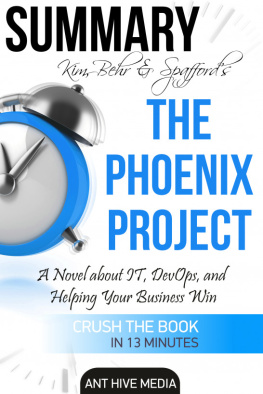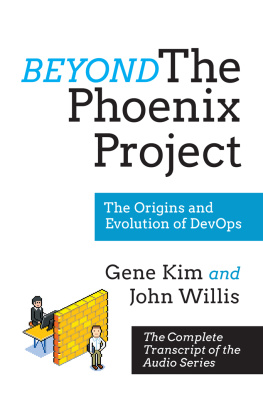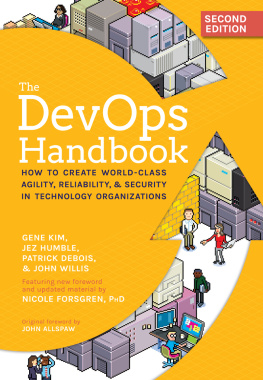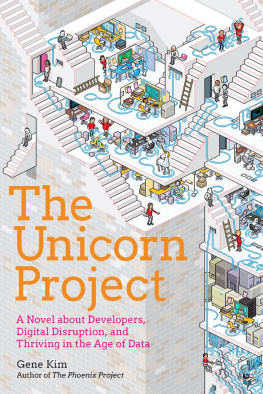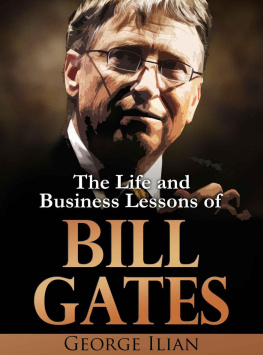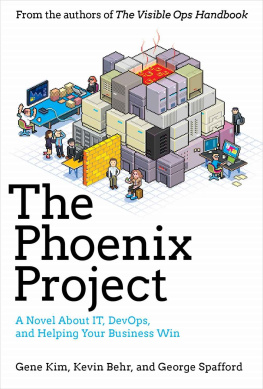Kim, Behr & Spaffords
The Phoenix Project
A Novel about IT, DevOps,
and Helping Your BusinessWin
Summary by Ant Hive Media

Visit
www.anthivemedia.com/freesummaries
to receive your pack of (5) e-booksummaries
FREE!
Check us out on Instagram:
www.instagram.com/anthivemedia/
Follow along on Facebook:
www.facebook.com/AntHiveMediaSocial
Please Note
This is a Summary of the original book. AntHive Media reads every chapter, extracts the understanding andleaves you with a new perspective and time to spare. We do the workso you can understand the book in minutes, not hours.
Smashwords Edition License Notes
This eBook is licensed for your personalenjoyment only. This eBook may not be re-sold or given away toother people. If you would like to share this book with anotherperson, please purchase an additional copy for each recipient. Ifyoure reading this book and did not purchase it, or it was notpurchased for your enjoyment only, then please return toSmashwords.com or your favorite retailer and purchase your owncopy. Thank you for respecting the hard work of this author.
Copyright 2016 by Ant Hive Media.
All rights reserved worldwide. No part ofthis publication may be reproduced or transmitted in any formwithout the prior written consent of the publisher
Limit of Liability/Disclaimer ofWarranty:
The publisher and author make norepresentations or warranties with respect to the accuracy orcompleteness of these contents and disclaim all warranties such aswarranties of fitness for a particular purpose. The author orpublisher is not liable for any damages whatsoever. The fact thatan individual or organization is referred to in this document as acitation or source of information does not imply that the author orpublisher endorses the information that the individual ororganization provided. This concise summary is unofficial and isnot authorized, approved, licensed, or endorsed by the originalbooks author or publisher. It is not intended to be used withoutreference to the original book.
A GIFT FOR YOU
As away of saying thank you we want to
offer you a pack of (5) e-book summariesFREE!
Available Here:
www.anthivemedia.com/freesummaries

GENERALOVERVIEW
Named after a business allegory, The PhoenixProject focuses on a fictional business that turns into aprofitable company after a big crisis-driven makeover happens intheir IT management procedure.
The character of Bill Palmer receives apromotion to become vice president of the IT department at PartsUnlimited (a company that deals, manufactures and retails variousautomotive parts) when it was having trouble financially and in theprocess of launching a unique project.
Almost every day in the life of Palmer asVP, his day was composed of unplanned work that the departmentdidn't have the resources to conduct. When he was working projectsfor the various department heads, Palmer met Erik Reid, a potentialboard member for Parts Unlimited. Their meeting turns interestingwhen Reid encourages Palmer to transform his IT department into aproduction factory of sorts. Each member of the department workedhard on two different and competing projects and at the same time,they attempted to change their incident and approval procedures.However, they still failed in launching the most crucial projectthey have, Phoenix, at the right time as well as with its targetfeatures.
The moment the Phoenix launch was derailed,the chief executive for the company gave the IT department aproviso either they meet obligations or they get outsourcedinstead. Shortly after, another problem surfaces which leads toPalmer resigning since his CEO keeps undermining his strategy forthe department. A couple of days afterwards, the CEO apologizes andrequests Palmer to return to the company with the urging of theboard members, including Reid who showed the CEO that his actionsactually kept the IT department from working properly. Soon after,Reid helps the IT department by supervising the work at the ITdepartment. During this, the department stops taking any new workand resumes their regular obligation. They also create a structurethat functions on the DevOps principles.
Because the IT department is now workingwith more focus and cohesion, they have more time to create newprojects including various recommendations and custom discounts tovarious customers. They also managed to automate testingenvironments, which made them easier to evaluate. They continued toimprove in each project including keeping track of gaps and doingrandom tests in security or emergency response. The moment all thechanges were made and the IT department adopted the Three Ways ofDevOps including focusing on the four kinds of work ((businessprojects, internal IT projects, changes, and unplanned work),shares for the company greatly improved which led the board todecide not to outsource the IT or split the company. The CEO thenplaces Palmer to be the next chief operating officer.
IMPORTANTCHARACTERS
Gene Kim
Co-founder of Tripwire, an open sourcecompliance and security automation company. He is also the authorof Visible Ops and DevOps.
Kevin Behr
Founder of Information Technology ProcessInstitute and also serves as chief strategist in Assemblage Pointe,a consultancy company he founded.
George Spafford
Worked on Gartner as research director forIT and DevOps.
Eliyahu Goldratt (1947-2011)
Author of the classic book, The Goal: AProcess of Ongoing Improvement (1984). This serves as the basis forThe Phoenix Project.
Wes Davis
Served as director for DistributedTechnology Operations in Parts Unlimited.
Steve Masters
The head CEO for the company PartsUnlimited.
Patty McKee
Worked at Parts Unlimited as director for ITService Support.
Sarah Moulton
Worked at Parts Unlimited as the senior vicepresident in the Retail Operations department.
Erik Reid
Worked at Parts Unlimited as a formerfactory director and possible board member.
Brent Geller
Worked at Parts Unlimited as lead engineerin the IT Department.
John Pesche
Worked at Parts Unlimited as CISO or ChiefInformation Security Officer.
CORECONCEPTS
CORE CONCEPT 1
Failures in business management that stifleIT productivity include undermining its importance and not givingthe IT department proper resources or the autonomy it needs to getthe job done.
CORE CONCEPT 2
In order for operations and development towork together properly, they should be considered as two halvesthat make up a whole instead of competitors. Both of them areactually part of the larger resource chains that starts with abusiness target or goal and ends with the deployment or productrelease.
CORE CONCEPT 3
To make the work process visible, one wouldneed total awareness of the control and resource spending with eachproject as they are discharged from the line. When it comes toreleasing work, it's important this be decided on the resourceavailability that's most limiting. This limiting resource is calledthe constraint.
CORE CONCEPT 4
The moment the constraint is known, it's theteam's prerogative to exploit this and subordinate it so it won'tbe relevant or necessary. Even if there is notable improvement inthe deployment chain but to the point of constraint then it willnot result in gains.

